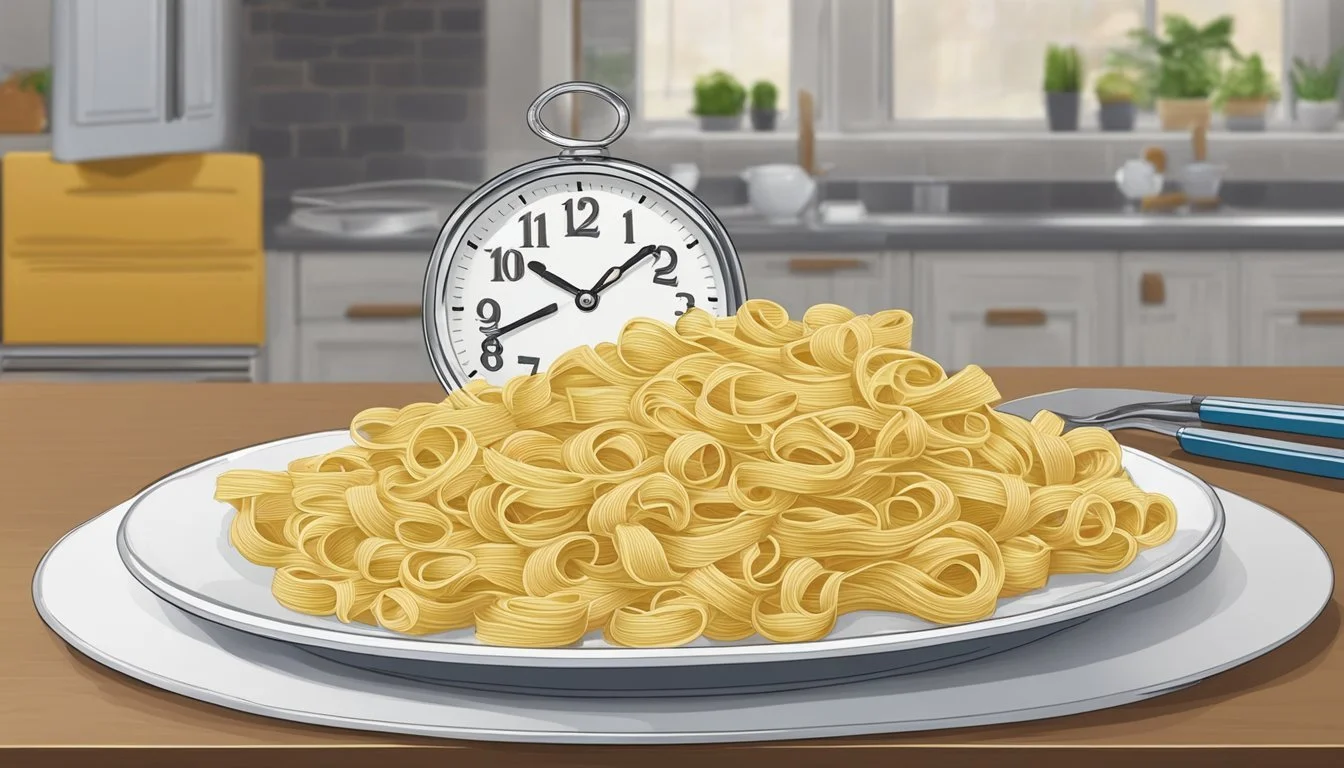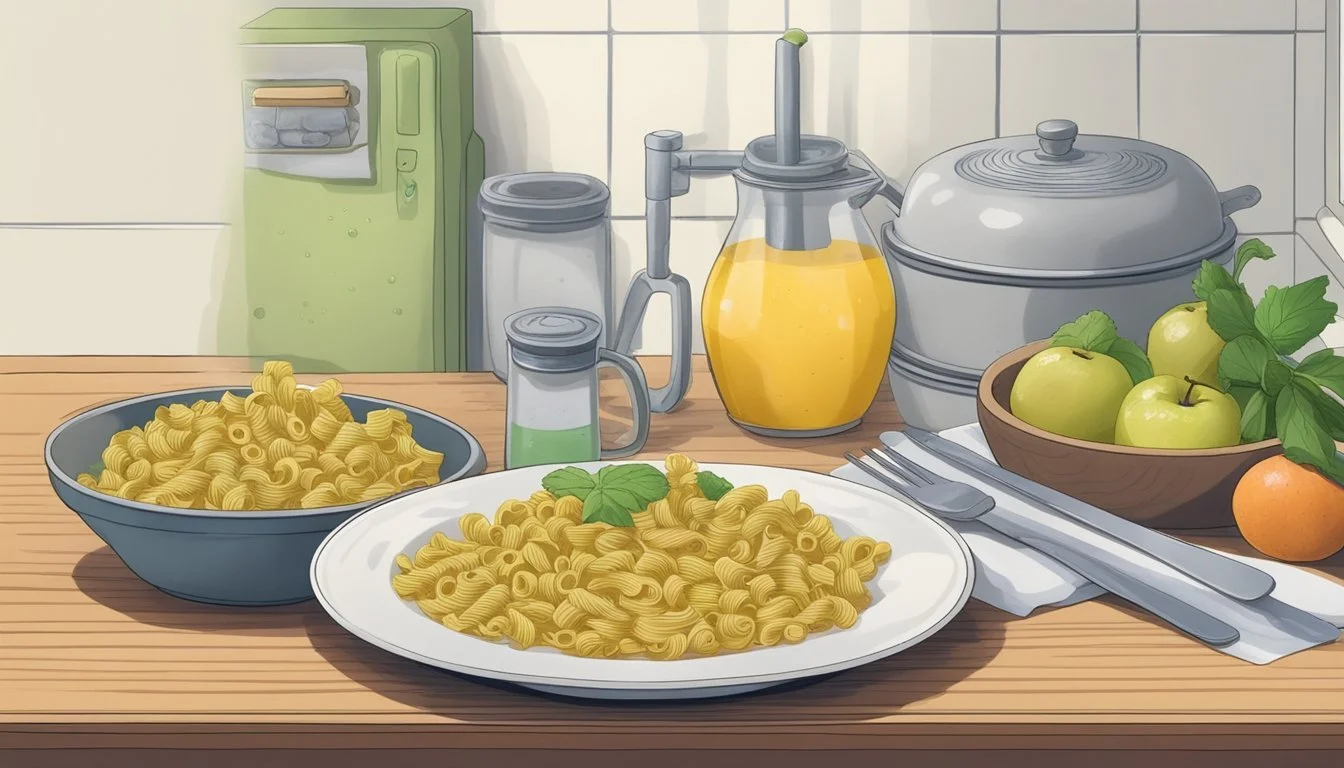How Long Do Cooked Pasta Dishes Last?
Storage Lifespan Explained
When it comes to storing cooked pasta (What wine goes well with pasta?) dishes (how long do cooked pasta dishes last?), understanding their shelf-life is crucial to ensure food safety and quality. Typically, plain cooked pasta can be refrigerated for 3 to 5 days. The storage time may vary depending on ingredients and sauce used; pasta with eggless sauces tends to last on the higher end of this range, while dishes containing perishable ingredients like mayonnaise or fresh seafood may spoil faster.
Storage practices play a key role in extending the life of cooked pasta dishes (What wine goes well with pasta dishes?). They should be kept in airtight containers immediately after cooking and cooling down, to prevent the growth of bacteria. Refrigeration temperature should be maintained at 40 degrees Fahrenheit or below to keep the pasta in a safe condition to eat.
For those who want to keep pasta for even longer, freezing presents a viable option. Cooked pasta can be frozen for up to 2 months when stored properly. Adding a small amount of oil can help prevent the pasta from sticking together in the freezer, ensuring it remains separated upon defrosting and reheating.
Understanding Pasta Shelf Life
When examining the shelf life of pasta, it's crucial to differentiate between its various forms: dry, fresh, and cooked. Dry pasta boasts an impressive shelf life due to its low moisture content. When kept in a cool, dry place, ideally in its original packaging or a sealed container, it can maintain quality for 1 to 2 years past its expiration date.
Fresh pasta (how long does fresh pasta last?), on the other hand, contains more moisture which shortens its shelf life appreciably. Refrigeration is necessary for fresh pasta, which typically lasts a few days.
Cooked pasta poses unique considerations. The duration cooked pasta lasts in the fridge depends on additional ingredients. Here's a brief breakdown:
Plain cooked pasta: 3 - 5 days
Cooked pasta with sauce: May vary based on sauce type, but typically 3 - 5 days
Cooked pasta with perishable ingredients: 2 - 3 days (e.g., mayonnaise-based dressings)
To safely store cooked pasta, one should ensure it is placed in the fridge within two hours of cooking, and it should be stored in airtight containers.
Pasta Type Fridge Shelf Life Plain cooked pasta 3 - 5 days Cooked pasta with sauce 3 - 5 days With perishable items 2 - 3 days
If pasta appears discolored, emits a foul odor, or has a slimy texture, it has spoiled and should not be consumed. Eating spoiled pasta introduces risks; it can lead to foodborne illness due to bacterial growth. Being vigilant about these guidelines ensures both safety and enjoyment of pasta dishes.
Proper Storage Techniques
Proper storage of cooked pasta enhances its shelf life while maintaining taste and reducing the risk of bacterial growth. Here's a comprehensive guide on how to store your pasta in the most effective ways.
Refrigerating Cooked Pasta
Shelf Life: Typically, plain cooked pasta can last 3-5 days in the fridge.
Temperature: Maintain the refrigerator at 40°F or below.
Container: Use an airtight container or securely seal a plastic bag to protect pasta from absorbing odors and drying out.
Adding Oil: Tossing lightly with olive oil or butter can help prevent sticking.
Freezing Pasta for Extended Life
Freeze Pasta: Spoon into airtight containers or freezer bags to freeze cooked pasta effectively.
Shelf Life: Frozen pasta maintains quality for up to 2 months.
Thawing: Defrost by running cool water over it in a colander or overnight in the refrigerator.
Freezer Burn: Prevent freezer burn by squeezing out excess air before sealing.
Storing Pasta Without Sauce
Separation: Always store pasta and sauces separately when possible to maintain quality.
Airtight Containers: For plain pasta, ensure it's cooled before placing in airtight containers or bags.
Oil Coating: A light coating of oil can keep pasta from sticking when refrigerated or frozen.
Best Practices for Storing Pasta with Sauce
Airtight Container: Store pasta with sauce in airtight containers to prevent moisture loss and contamination.
Shelf Life: Pasta with eggless sauce can last up to 5 days, whereas pasta with mayonnaise or perishable items should be used within 2-3 days.
Special Considerations for Fresh and Gluten-Free Pasta
Fresh Pasta: Store fresh homemade wheat pasta for 4-5 days and fresh store-bought wheat pasta for 1-3 days in the fridge.
Gluten-Free Pasta: Gluten-free pasta may have a different shelf life; always check the packaging for recommended storage times.
Pantry Storage for Uncooked Pasta
Dry Pasta: For uncooked dry pasta, store in a cool, dry place in an airtight container or package, away from moisture sources.
Shelf Life: If stored properly, dry pasta can keep its quality for up to 2 years.
Reheating and Serving Leftovers
When rejuvenating leftover pasta dishes, it’s essential to employ methods that preserve the dish's taste and texture while ensuring it's safe to consume. Using appropriate reheating techniques can make the difference between a delicious meal and a disappointing one.
Safe Thawing and Reheating Methods
To safely thaw and reheat leftover pasta, it's crucial to follow these guidelines:
Thawing: If pasta is frozen, transfer it from the freezer to the refrigerator, allowing it to thaw overnight. Avoid thawing at room temperature to minimize the risk of bacterial growth.
Reheating: The microwave, oven, and stovetop are all effective for reheating pasta. Ensure the temperature reaches at least 165°F to kill any potential bacteria.
Method Microwave Oven Stovetop Time 1–2 minutes 20 minutes at 350°F Varies Best For Quick reheating Saucy pasta dishes Restoring texture Benefits Speed, convenience Even heating Control over heat
Maintaining Texture and Flavor
To maintain the texture and flavor of reheated pasta, consider the following:
Microwave: Add a little water before heating to prevent drying out. Stir periodically.
Oven: Covering with foil retains moisture. For extra flavor, add cheese or a drizzle of oil in the last few minutes.
Skillet: Reheat on the stovetop using a bit of oil or butter to prevent sticking and enhance taste.
Ensuring Food Safety
Adhering to food safety practices diminishes the risks of food poisoning and ensures the pasta is safe to eat:
Temperature: Leftover pasta should be stored in the refrigerator within two hours of cooking and reheated thoroughly.
Bacteria: Avoid cross-contamination with raw foods and always reheat to the appropriate temperature.
Smell and Taste: Always inspect leftovers for any off-putting smell or taste before consumption, to mitigate the risks of eating expired pasta.
Indicators of Spoilage
When assessing whether cooked pasta dishes have spoiled, one can look for several key signs. Spoilage of cooked pasta can manifest through changes in smell, appearance, including discoloration and mold growth.
Smell: Spoiled pasta typically emits an unusual or off odor. A tangy, sour scent, or an ammonia-like smell is a strong indication that the pasta should not be consumed.
Discoloration: Pasta that has changed in color from its original hue to a duller, darker or even different color might indicate spoilage.
Appearance: A slimy or gooey texture on the pasta is a clear sign of spoilage. The pasta should have a consistent and firm texture, not a slippery one.
Mold Growth: Any visible signs of mold, which could manifest as fuzzy spots or patches of blue, green, white, or black, indicate that the pasta is no longer safe to eat.
Indicator Details Smell Off, tangy, sour, or ammonia-like odor Discoloration Change from original color to dull, darker, or another color Appearance Slimy, gooey texture Mold Growth Fuzzy spots, often blue, green, white, or black
If any of these indicators are present, the pasta should be discarded. It is always better to err on the side of caution to avoid the risks associated with consuming spoiled food.
Creative Uses for Leftover Pasta
When confronted with leftover pasta, one has numerous options to transform it into a delectable new dish. Here are some inventive ideas to maximize the flavors and textures of any pasta leftovers you have in your refrigerator:
Skillet Sensation: Heat a skillet and add a bit of oil or butter. Toss in the leftover pasta until it's crispy and golden, creating an entirely new texture profile.
Oven-Baked Delights: Consider turning that pasta into a baked pasta dish. Simply mix the leftovers with some cheese, perhaps additional sauce or vegetables, and bake it in the oven until bubbly and crisp on top.
Microwave Magic: If time is not on your side, the microwave can revitalize leftover pasta. Sprinkle some water over the pasta to keep it moist, cover, and microwave until hot. This works well for saucy pasta or pasta that needs a simple refresh.
Pasta Salad: Refrigerated pasta is perfect for cold dishes. One can transform it into a pasta salad by adding a medley of fresh veggies, a protein source like tuna or chicken, and a light dressing.
Reinvented Dishes: Baked Mac and Cheese or a Pasta Frittata are perfect examples of dishes that can incorporate leftover pasta, giving it a new life with additional ingredients.
Here is a brief rundown:
Method Description Skillet Crisp up pasta in a pan for a new texture. Oven Create a baked pasta dish, adding cheese and vegetables for a new meal. Microwave Quickly reheat with additional water to maintain moisture. Pasta Salad Combine with fresh ingredients and dressing for a refreshing meal. Reinvented Dishes Use as a base for dishes like Mac and Cheese or Frittata for a quick meal.
Each method offers a distinct take on using up pasta leftovers, ensuring minimal waste and maximum enjoyment.
The Impact of Different Pasta Types
The shelf life of cooked pasta dishes is influenced by the type of pasta used, whether it's stuffed, wheat-based, or an alternative such as gluten-free or pea-based. Each type has distinct characteristics affecting moisture content, texture, and ultimately, how long the pasta maintains its flavor and food safety.
Shelf Life Variations by Pasta Shape
Spaghetti: Generally lasts 4-5 days when refrigerated.
Tortellini (stuffed pasta): Can be kept for around 4 days in the fridge.
The shape and size of pasta can affect its surface area and how it retains moisture, leading to varying shelf lives. Spaghetti, due to its long and thin shape, may dry out faster, while the filling in stuffed pasta like tortellini can contribute to a shorter shelf life due to additional moisture.
Fresh vs. Dried Pasta Longevity
Fresh pasta: Keeps for 1-5 days in the refrigerator.
Dry pasta: After cooking, it should be eaten within 3-5 days.
Fresh pasta contains more moisture than dry pasta, making it more perishable. Dry pasta, which has had most of the moisture removed, can last much longer uncooked, but once it is cooked, the shelf life condenses significantly due to the reintroduction of water.
Wheat and Alternative Pasta Considerations
Cooked wheat pasta: Stays fresh for 3-5 days if refrigerated properly.
Gluten-free pasta: Often has a similar shelf life to regular wheat pasta, roughly 4 days.
Pea-based pasta: Shelf life can vary; typically aligns with gluten-free options.
Wheat pasta is a staple due to its resilience and flavor, maintaining freshness when stored correctly. Gluten-free and pea-based pastas are designed to offer alternatives for dietary restrictions, and while their shelf lives are comparable to wheat pasta, individual brands and ingredients can cause variation. These alternative pastas may have different texture changes over time when compared to traditional wheat pasta, which could influence the perceived freshness.




